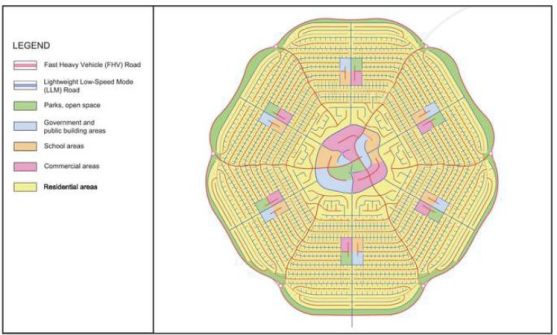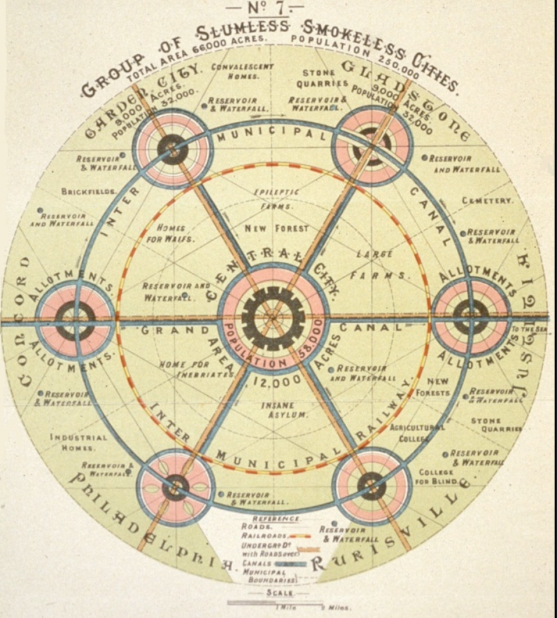The American dream of homeownership has been embedded in our consciousness, that picket fence, the half-acre yard, you know the routine. There is one problem with this vision: with the large lots, the 2-car garages, and wide, curvilinear streets, sprawl, disconnectedness, and the automobile have come to rule the day.
Many great accounts of how suburbia came to be the dominant development paradigm in America are available, so I will just summarize here. James Howard Kunstler’s masterpiece The Geography of Nowhere serves up a grave account of the tragic rise and decline of the American landscape. For a focus on the political economy of the suburbanization of America, Kenneth T. Jackson’s Crabgrass Frontier is an excellent resource. And from the team at the forefront of New Urbanism, Andres Duany, Elizabeth Plater-Zyberk, and Jeff Speck; Suburban Nation is a great resource for discovering the coming change in urban form.

A sprawling suburb near Phoenix, Arizona
This change is urban form is being inspired partially by us millennials, who aren’t too enamored by the current auto-dominated world in which we’ve grown up. A recent report by US PIRG show that millennials are reluctant to drive, a trend that many are associating with a blossoming online social world. Another interesting trend causing peak–driving and peak-VMT is the large number of baby-boomers dropping out of the workforce. The US PIRG report asserts that it may be 2040 before driving rises to the 2007 peak again, despite the 21% increase in population over the same period. The New York Times recently published an article covering this trend as led by the youth of the nation, and Streetsblog DC called my attention to a part of the report that is especially interesting – we millennials won’t shun the automobile forever, just until we get old, and even then, we’re probably not going to drive as much.

IBBN Flatpack Home
All this leads me to my point – the model for American homeownership needs to be adjusted to this new demographic trend. FHA and VA loans have special requirements tied to them that tend to favor newly constructed homes, most of which have been constructed at the fringes of cities. Last year, The Atlantic published an article about the decline of homeownership among young people, with the take-away points that young people are finding less employment, staying single longer, and therefore, buying less homes. Here is an observation from a young person who has secured a mortgage – the houses available aren’t what I want! I would love to see a condo, or maybe a townhome, that was in a denser urban area, that would allow me to sell my car and make a bigger downpayment, and would still qualify for an FHA loan, so I don’t have to have that 20% down. Take this home for example: a flatpack (think IKEA) home that can I can build myself in just 6-8 weeks. That’s the idea that some Dutch companies are floating to increase homeownership among the younger generation there. The cost is just $150,000 dollars, there is no labor cost, because you build it yourself, meaning you can customize it, the cost is fixed, and the financing options are available for anyone with an income of about $38,000 to $58,000. That’s solidly middle-class, where most of us millennials can expect to land, given the decline in real wages over the past 40 years (see chart below). Another advantage of these flatpack homes is that many jurisdictions in the U.S. will allow them in site-built only neighborhoods (usually the most restrictive zoning classification), as they are built on-site by the homeowner.

Long-term Real Median Earnings for Males
It’s clear to me that the current American model of homeownership, two-and-a-half kids, Spot, Fido, and that great, big lawn is out-of-date. Our generation, and probably the following generations, will continue to demand walkable, bikeable, connected, and vibrant cities for the foreseeable future. This is not just because it is the cool thing to do (though Jeff Speck’s new book, Walkable City has certainly inspired a trend among planners), it’s because we want to shy away from the dependence upon or cars and fossil fuels and get back to a world where we can walk or bike to work, and get some exercise on the way.
How can we plan for peak-auto, cater to a generation who would like to walk or bike to work, or perhaps even telecommute? We can invest in more bicycle infrastructure, as I mentioned in my last post, but we can also encourage a culture of activity, rather than a culture of gridlock and waste.






